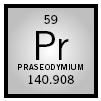Praseodymium

MELTING POINT:
935°C
BOILING POINT:
3,017°C
DENSITY:
6.475 g/cm
3
MOST COMMON IONS:
Pr
3+
,
Pr
4+
In 1885 C. A. von Welsbach isolated two elements as oxides, praseodymium (the word meaning "green twin") and neodymium (meaning "new twin"), from a mixture of lanthanide oxides called didymia. The oxides can be transformed to fluorides by reaction with HF at 700°C (1,292°F), or with NH 4 HF 2 at 300°C (572°F). The hydrated fluorides are then dehydrated in vacuo in a current of HF gas. The metals praseodymium and neodymium are obtained via metallothermic reduction with calcium at approximately 1,450°C (2,642°F), or via electrolytic reduction of the melts. The metals can also be obtained from anhydrous chlorides, obtained via reaction of the oxides with ammonium chloride at 350°C (662°F), which are then reduced with lithium-magnesium at approximately 100°C (212°F).
Praseodymium halides (except the fluoride), nitrate, and acetate are soluble. The hydroxide, carbonate, oxalate phosphate, and oxide compounds are insoluble. Praseodymium's solutions and most of its solids are green.
When oxo-compounds of Pr(III) are ignited in the atmosphere, a black oxide of composition Pr 6 O 11 (approximately) is obtained. Fluorocomplexes of Pr(IV) that have the compositions Na 2 PrF 6 , Na 7 Pr 6 F 31 , and PrF 4 have been obtained.
Pr(III) salts and complexes are weakly luminescent. The salts are used to color some special glasses and as pigments in ceramics. The compound Zr 1− x Pr x SiO 4 is used often as a yellow pigment in the ceramic industry; it is very stable in color and resistant to high temperatures. Pr(III), in Pr 2 S 3 , is an excellent pigment for plastics and paints. Other uses of praseodymium include tires (Pr-doped ZrSiO 4 ), photographic filters (Pr 2 O 3 ), and welding masks (Pr-Nd).
Bibliography
Maestro, P. (1998). "From Properties to Industrial Applications." In Rare Earths , ed. R. S. Puche and P. Caro. Madrid: Editorial Complutense.
Moeller, Therald (1973). "The Chemistry of the Lanthanides." In Comprehensive Inorganic Chemistry , ed. J. C. Bailar, Jr.; H. J. Emeléus; Sir Ronald Nyholm; and A.F. Trotman-Dickenson. Oxford, UK: Pergamon Press.